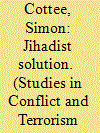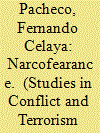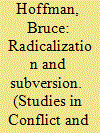| Srl | Item |
| 1 |
ID:
093009


|
|
|
|
|
| Publication |
2009.
|
| Summary/Abstract |
Homegrown Sunni extremists (jihadis) and Latin American street gang members (cholos) represent potential threats to national security. Both groups are known to inhabit the video- sharing website YouTube. Videos representative of each group were selected at random, and the visual motifs in the videos were categorized. Findings suggest similarities and differences between the two groups that may have significance for how practitioners address each threat, and for determining the likelihood that the two groups may begin to work in concert. The portraits that emerge of jihadis and cholos may assist in developing strategies to counter the violence perpetrated by each.
|
|
|
|
|
|
|
|
|
|
|
|
|
|
|
|
| 2 |
ID:
093011


|
|
|
|
|
| Publication |
2009.
|
| Summary/Abstract |
This article explores the historical emergence of Islam in East Africa, details the political background of Tanzania and Kenya, the role of Islam in each country, and U.S. foreign policy in the region. The recent U.S. strategy of intelligence-sharing with Kenya, training and military support to both Kenya and Tanzania, and air strikes in Somalia are assessed. In addition to the current military emphasis, the United States should incorporate more "soft" options, such as the promotion of democratic governance in these nascent democracies through political assistance in constitutional, judicial, and law-enforcement reform, as well as encouraging greater inclusion of Muslims in the political system.
|
|
|
|
|
|
|
|
|
|
|
|
|
|
|
|
| 3 |
ID:
093018


|
|
|
|
|
| Publication |
2009.
|
| Summary/Abstract |
On one night in October 2007, at an event organized by The New Yorker and chaired by Bill Buford, Martin Amis and Ian Buruma convened to discuss the theme of the monster in politics and literature.
|
|
|
|
|
|
|
|
|
|
|
|
|
|
|
|
| 4 |
ID:
093004


|
|
|
|
|
| Publication |
2009.
|
| Summary/Abstract |
Throughout the 1980s and 1990s Mexican cartels' leadership was nationalistic and entrepreneurial, focusing their efforts specifically on the profitable U.S. drug consumption market. Their goal was to subvert the Mexican state, not challenge it. Today the various Mexican cartels appear to be headless, bereft of any leadership or led by thugs who have no allegiances and have begun focusing their enterprises on the increasing national drug consumption demand. This has caused anarchy within the different cartels' ranks and among potential smaller competitors vying for territorial control resulting in an unprecedented escalation of drug-related violence that qualifies as narcoterrorism. The Mexican state is challenged directly for control over the legitimate use of force and seems unable to rein in the uncontrolled level of violence. Why? The following analysis discusses politicoeconomic as well as psychosocial factors that explain the evolution of these violent trends in Mexico, whose society demands an end to state corruption and a firm plan to ensure citizen security.
|
|
|
|
|
|
|
|
|
|
|
|
|
|
|
|
| 5 |
ID:
093013


|
|
|
|
|
| Publication |
2009.
|
| Summary/Abstract |
This article analyzes the suicide bomb attacks on four London transportation targets on 7 July 2005 and the plot to bomb simultaneously at least seven American and Canadian passenger airliners as they departed from London's Heathrow Airport. American, British, and Pakistani authorities thwarted this planned attack in August 2006. Both incidents are among the most important Al Qaeda operations in recent years. Initially, they were dismissed by the authorities, pundits, and the media alike as the work of amateur terrorists-untrained "bunches of guys" acting entirely on their own with no links to Al Qaeda. Subsequent evidence, however, has come to light, which reveals clear links to senior Al Qaeda commanders operating in Pakistan's lawless frontier border area with Afghanistan.
|
|
|
|
|
|
|
|
|
|
|
|
|
|
|
|
| 6 |
ID:
093006


|
|
|
|
|
| Publication |
2009.
|
| Summary/Abstract |
Existing literature is weak in explaining strategic change among terrorist movements, especially regarding the question of why these organizations often switch between contesting the external enemy, usually the government or the occupying power, and the internal arena in which they compete against fellow rebel groups. A rebel force facing diminishing returns from a formerly successful tactic with no equally effective tactical substitute in sight is likely to switch from conflict against a government to achieve dominance in the rebel camp. The terrorist movement will switch from the external to the internal arena even if such substitution compromises the overall goals of the rebel camp. The following article explores these dynamics in Hamas's strategy in the latest round of conflict between the movement and Israel.
|
|
|
|
|
|
|
|
|
|
|
|
|
|
|
|